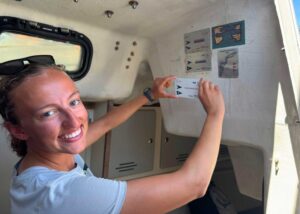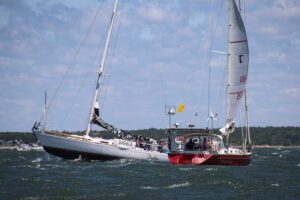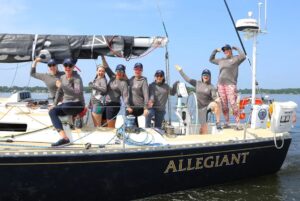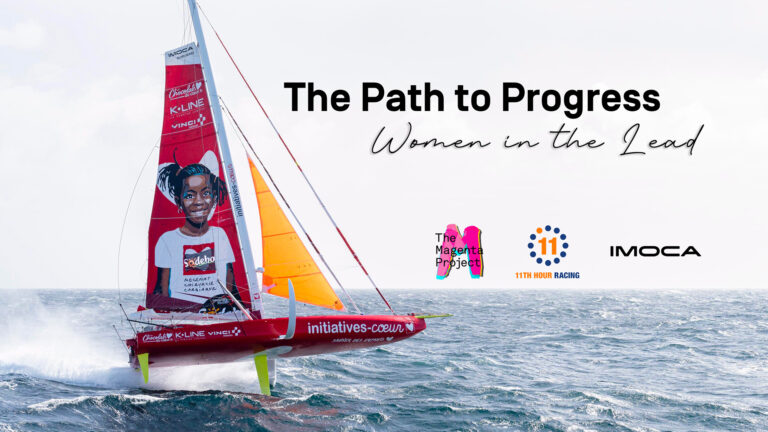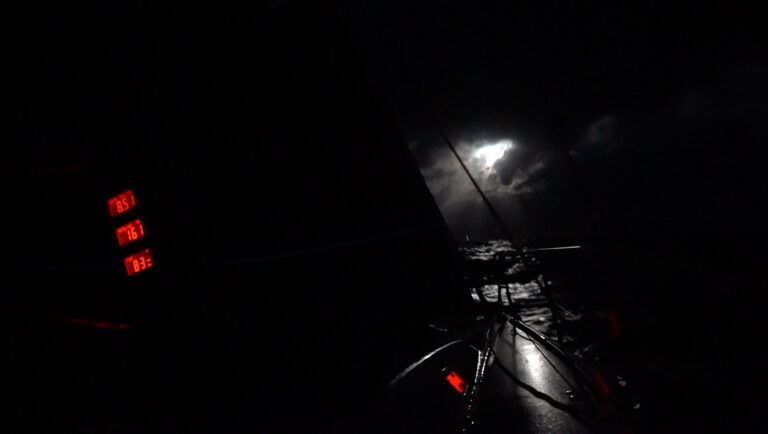A charter in italy means seven days of feasts, for the eyes and the palate.
C’ un parcheggio qui vicino?
Is there a parking lot nearby?
The hazards of being a tourist in the Naples area and along the Amalfi Coast are well known and mostly have to do with the narrow roads, testosterone-saturated drivers, too few places to park, and too many people. We had to find out for ourselves, of course, so we elected to keep the rental car our sailing companions, Dave and Mary Ann Chase, had driven down from Tuscany. We thought it would be easier to see Pompeii by car than to find a harbor safe enough to leave our soon-to-be-chartered boat for the day. Then, too, we couldn’t miss the experience of driving SS 163, the famously difficult—narrow, winding, heavily trafficked—Amalfi Drive.
Two days of car-based tourism seemed to be about enough, so we withdrew to Procida, a tiny island with ferry service to Naples and, since it’s just over a mile north to south, absolutely no reason to have a car. Procida’s tourist draw is dwarfed by that of neighboring Capri and Ischia, but several charter companies have bases in one or the other of its two harbors. Our boat, from Cosmos Yachting, lived in Chiaiolella, the harbor on the island’s south side, a short walk from our nice, simple hotel and ringed by pleasant restaurants.
Ha un buon vino rosso?
Do you have a good red wine?
We boarded our Beneteau 463 late on a Saturday afternoon in early June, and, with an eye on the clock (the stores were closed until 5 p.m. and would not be open on Sunday), Mary Ann and I left the men to deal with the boat checkout and set off to provision. We’d already noticed that the road leading north from the harbor was lined with small shops—groceries, bakeries, wine stores—and were pleased to find that everything on our list was available at one place or another. Ursula, the base manager, had thoughtfully brought some of the heavy stuff to the boat by car, so we bought as much food as we could schlep. I like to go food shopping in Europe; it’s a good way to enter the life of whatever town you’re in, and everything always looks (and is) delicious.
Ursula returned on Sunday morning for a chart briefing and discussion of possible routes. The Gulf of Salerno isn’t very large, and we agreed that Agropoli, the nearest port to the ruins of Paestum, would be a reasonable farthest destination. I made a list of places where we might anchor—though, Ursula said firmly, only in settled weather and with one person staying on the boat—and harbors where ferries don’t go. Given that a week is short and that the job of staying aboard would be unfair to the anchor watcher, we decided then and there to pay the hefty price of freedom and stay in marinas. The waters are deep here, and the anchorages are open roadsteads, protected only by the cliffs above them. It seemed a little dicey to assume that we would be in the lee of whatever wind showed up, if it did.
Dove posso ormeggiare?
Where can I moor?
It was almost lunchtime when we finally departed Procida for Sorrento, relieved to be navigating by efficient chart and line of sight instead of the inadequate road map that came with the car. The only traffic to watch out for was the occasional ferry, the day was pleasant, and we tried our best to fill the sails in the lethargic breeze. At least the conditions were favorable for preparing lunch—the first of many increasingly elaborate antipasti.
It seems reasonable to enter a harbor and, in a positive voice, ask “Where can I moor?” Since it was Sunday, still early in the tourist season, and not a holiday weekend, we naturally expected a positive response when we pulled into Sorrento’s Marina Grande, but no such luck. Nor was there anything at Marina Piccola next door. We saw a cruising boat preparing to anchor, but the darkening skies indicated that “settled weather only” was not in the cards. Fortunately, Marina Piccola suggested we keep going along the coast a few miles to the Marina di Cassano, a harbor used by small powerboats and fishermen, but sometimes able to accommodate a cruising sailboat. Our rescuer there was a kind man from New Jersey. He arranged for us to pull in and tie up temporarily; then the marina crew moved us over to the deeper water at the fuel pier when the marina closed for the night.
Mary Ann and I got a pretty good idea of just how high the cliffs behind the marina were by climbing up five nearly vertical switchbacks in a windy downpour. We were hoping to find the bus to Sorrento, which according to the chart was pretty far away, but my phrase book wasn’t up to the task. So we walked for a while in the rain, hoping that either Sorrento or the bus would magically appear, and finally went back to the boat to drown our disappointment in the buon vino rosso.
By the next morning the rain and the wind had both disappeared, so we motored to Amalfi, our intended jumping-off place for Agropoli, some 24 miles east. George, his Navy navigation course in the distant past, had brought a pack of flash cards for a refresher on IALA-A buoyage (used in all of Europe, and elsewhere), so he amused himself by identifying marks whose meanings were pretty obvious. There are some rocks between Sorrento and Amalfi, but they’re in plain sight, they’re marked on the chart, and the tide is too negligible to cover them. The most useful thing—that harbor entrances are marked by a green flasher—we figured out for ourselves.
Amalfi has a lovely harbor and a congenial harbormaster. The number of large fenders we carried should have told us that backing our wide-bodied Beneteau into a space fit for a dinghy could be tricky. The Italian word for stern is poppa, should you need to ask, but we didn’t see a single boat moored bow-to the concrete quai. A profusion of lines, plus a laid mooring, need to be picked up simultaneously with the single boathook while, at the same time, the crew runs around with fenders and aims for the cleats. Although we’d walked the docks in Procida trying to figure out where all the lines came from and went to, the process wasn’t intuitive. However, help was always available from the harbor crews—agile guys who hopped on board and sorted things out. Accept this help. It’s useful to remember the word scotare (fend off).
Amalfi, once one of the four maritime republics of Italy, is a charming town with a medieval core. Given this history, considerable civic space is devoted to Flavio Gioia, the claimed inventor of the compass. It’s a pleasant place to walk around, sample gelato, stop for a cappuccino, and, especially, provision.
We found a bus about to leave for Ravello, which hovers at the top of a narrow, zigzagging road that passes by lemon and olive groves, so we took it. Ubiquitous buses make it easy to combine tourism with sailing; you can go just about anywhere on the mainland or on the islands for little money, and service is frequent. If you stop, for example, at Positano, where you can pick up a mooring (settled weather only), a bus will come by to take you up to the town.
Cerco uno bollettino meteorologico
I’m looking for a weather forecast
It seemed prudent to get a weather forecast before we set out for Agropoli, the longest leg of our cruise, and we’d been trying to find one of the hourly English-language broadcasts on channel 68. (It was two days later, when we were under sail in the middle of the gulf, that we realized the VHF was working fine, but the tall cliffs blocked the signal.) We asked the Amalfi harbormaster if he had an update, but he didn’t. We even stopped at an Internet caf to look for a marine forecast on line.
When everyone overslept the next morning, it was clear we’d have to change our plans. Yet sometimes these goofs are fortuitous. Yes, we could spend another night in Amalfi harbor; yes, we had time to re-reprovision (fresh bread and more olives); yes, the sky turned black as we were sitting down to lunch in the cockpit. Then came the thunder, the lightning, the strong wind, and the torrential rain. We could have been partway to Agropoli; instead we were napping, rocked by the surge.
Dolce far niente
How sweet to do nothing
I have known Dave and, certainly, George long enough to know they wouldn’t cotton to the hordes of daytrippers who come by ferry to Capri and Ischia. Since it was early in the season, we found space in both the Marina Grande on Capri—but at a price (€165!)—among the megayachts and at the quiet Casamicciola marina on Ischia. We took the funiculare to Capri Town, enjoying the views along the way but not the almost impenetrable crowds walking past the gazillion fashionable shops. We couldn’t persuade the guys to then take a bus to Anacapri—our loss. Ischia, which we managed to reach under sail, suffered from guilt by association. I hopped a bus that did a circular route around the island for an investment of a couple of euros.
As Dorothy discovered when she clicked the ruby slippers, there’s no place like home. We pulled into the Cala di Corricella, a true anchorage with a sand bottom at the northeast tip of Procida, in time for lunch and used our anchor for the first time. The belvedere we had visited a week before was above us; some small sail and powerboats were also enjoying the day there. It looked like a great place for a swim, but only kids were in the water, and only briefly.
It was a quick trip back to the Chiaiolella marina, and a convenient breeze came up to bow-thrust us into an outside slip. We put the fenders in the right places and the numerous lines in the right places, and that was that.
Why go: The famous waters, the food, the wine, the scenery. See the Amalfi Coast in your own boat—it’s much less nerve-racking than driving.
When to go: Summers are hot and crowded. We beat the crowds (mostly) by chartering the first week of June. It surely wasn’t hot—sometimes not even warm.
What to expect: Charts and Xeroxed pages from Rod Heikell’s Italian Waters Pilot (Imray), the only cruising guide in English, were on board. Linens, however, were not (though they were found for us). Be sure to check whether linens are supplied. Bring a tourist guide for shore excursions and an Italian phrase book (I used Berlitz; I had Lonely Planet, too, but it deals more with social situations we were unlikely to get into). I also made a list of potentially useful phrases from Yachtsman’s Ten Language Dictionary, by Barbara Webb and Michael Manton (Sheridan House).
Language problems: You’ll do fine in English, but you’ll have more fun in Italian. I took a Beginning Italian adult-education class a few years ago, so I was able to pronounce Chiaiolella and to be understood when I asked questions, though I wasn’t too reliable at translating the answers. Practice saying Io non capisco (I don’t understand). We booked the Beneteau 463 through Cosmos Yachting (210-764-6125; www.cosmosyachting.com; [email protected]). We flew British Midland to Naples from London Heathrow; there are many ways to get to Naples.

